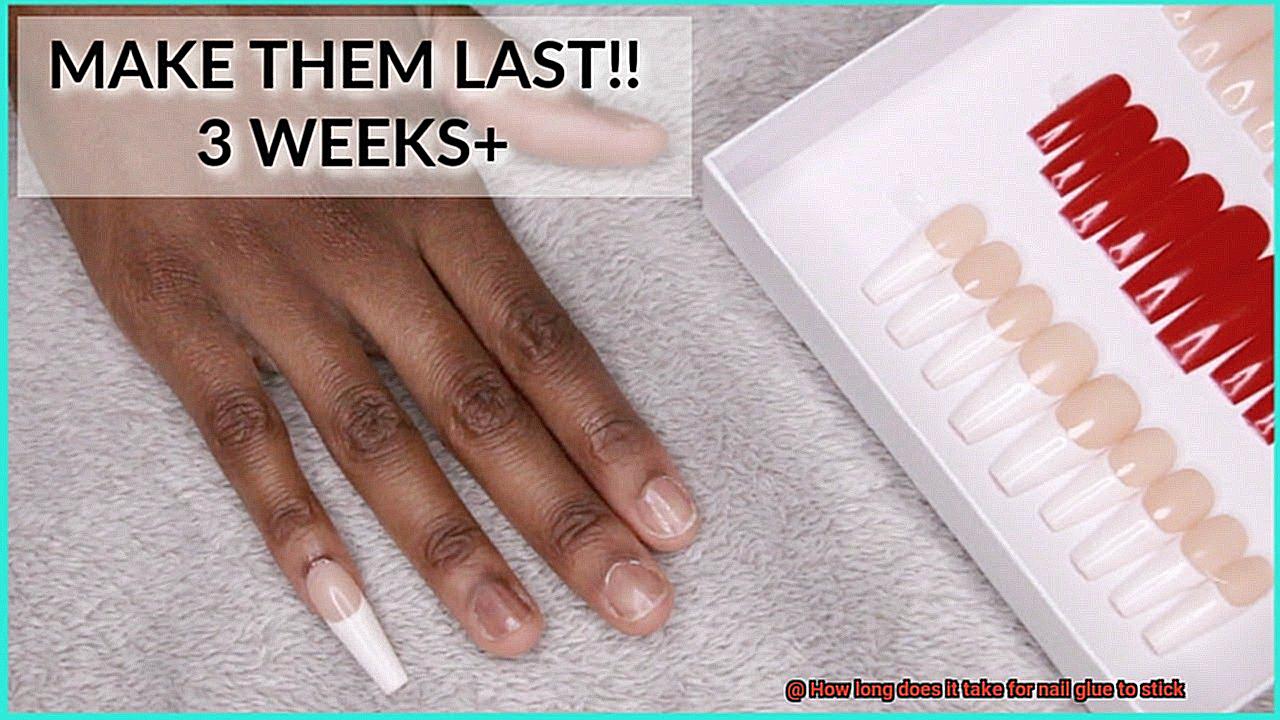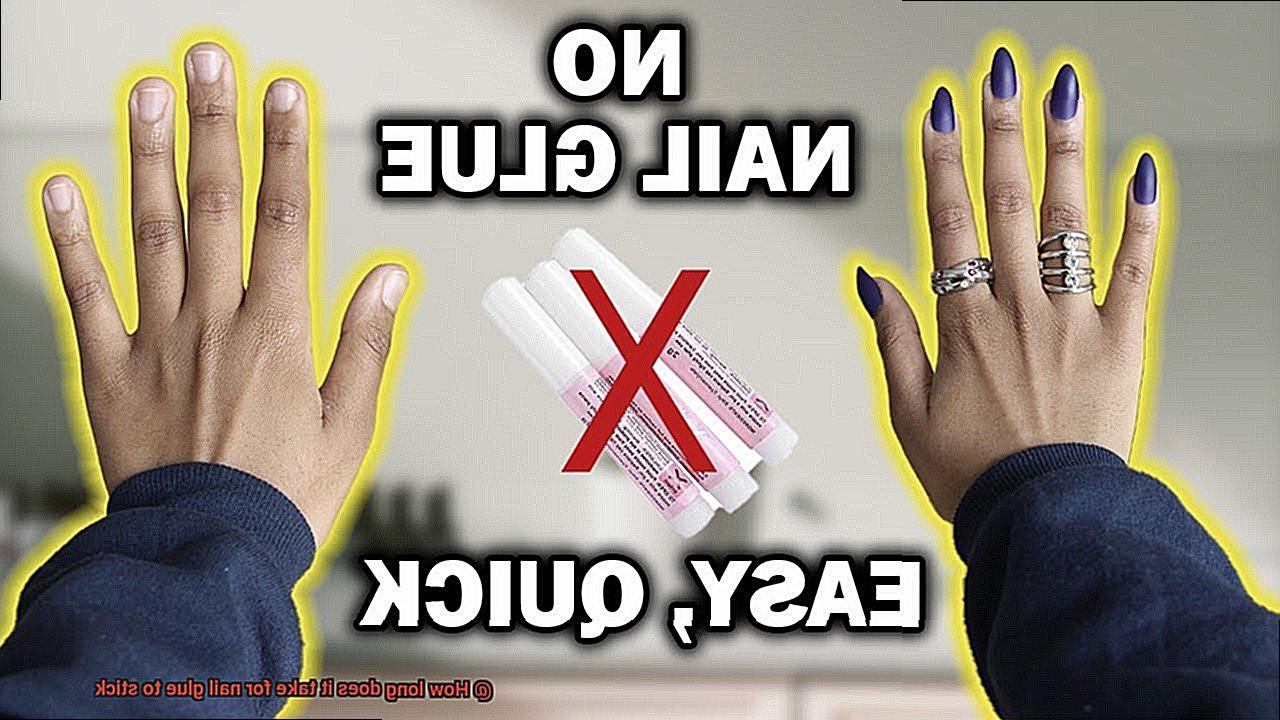Are you tired of your artificial nails falling off after just a few hours? Nail glue can be a lifesaver, but how long does it take for it to actually stick?
If you’re new to nail glue application, don’t worry. We’ve got you covered. In this article, we’ll dive into the nitty-gritty of nail glue drying times and what factors can affect them.
But first things first: taking your time and following the instructions is crucial when applying nail glue. Rushing through the process can lead to disastrous results. Trust us, we’ve been there.
Now, let’s talk about drying times. Did you know that different types of nail glue have varying drying times? That’s right. Some dry in just a few seconds while others take several minutes. We’ll break down each type and give you tips on how to make them work for you.
So if you’re ready to achieve the perfect manicure with long-lasting results, keep reading. Whether you’re a pro or a beginner, we’ve got everything you need to know about how long it takes for nail glue to stick and how to use it like a pro.
Factors that Affect the Bonding Time of Nail Glue
Contents
- 1 Factors that Affect the Bonding Time of Nail Glue
- 2 Tips for Using Nail Glue Properly
- 3 Different Types of Nail Glues Available in the Market
- 4 How to Choose the Right Nail Glue for Your Needs
- 5 Common Mistakes to Avoid when Applying Nail Glue
- 6 How to Remove Excess or Dried-up Nail Glue
- 7 Home Remedies to Strengthen Weak or Damaged Nails
- 8 When to Seek Professional Help with Your Nails
- 9 Conclusion
Nail glue bonding times can vary based on several factors. In this article, we’ll explore the different factors that can impact how long it takes for nail glue to properly stick.
The type of glue used is a significant factor. Different nail glues have unique bonding times. Cyanoacrylate glues bond quickly, usually within seconds, while resin-based glues take longer to bond, often requiring up to ten minutes. It’s essential to find the right type of glue that fits your needs.
The quality of the nail glue is another crucial factor. High-quality glues tend to bond faster and last longer than lower quality ones. Investing in a good quality nail glue ensures optimal results.
The technique of application also impacts bonding time. Applying too little or too much glue can interfere with the bonding process. If the glue is applied too thinly or unevenly, it may not bond well and could take longer to set. Alternatively, if too much glue is applied, it could take longer to dry and result in a messy application.
The condition of your natural nails can also impact how long it takes for the glue to bond. Dirty or oily nails may prevent the glue from adhering correctly, resulting in a weaker bond. Ensure that your natural nails are clean and dry before applying any nail glue.
Temperature and humidity levels in the environment where the glue is applied can also affect its bonding time. Warm and humid environments tend to accelerate the bonding process, while cold and dry environments can slow it down. It’s important to consider the environment when applying nail glue.
Lastly, the type of artificial nail being used can impact bonding time. Some types of artificial nails require more adhesive strength than others, which means that a stronger adhesive or longer bonding time may be necessary.

Type of Glue
Nail glue is here to save the day. However, with so many different types of nail glue available in the market, it can be challenging to figure out which one to choose. Let’s take a closer look at the world of nail glue and explore the various types and their properties.
First on our list is cyanoacrylate glue, also known as super glue. As the name suggests, this fast-drying adhesive is a real superhero when it comes to bonding your nails quickly. It takes only a few seconds for this glue to stick to your nails, making it an excellent option if you’re short on time. However, keep in mind that this type of glue can be brittle and may not last as long as other types.
If you’re looking for a more flexible and long-lasting option, then resin glue might be what you need. This slower-drying adhesive takes around 10 seconds to a minute to bond with your nails, depending on how much you apply. The advantage of resin glue is that it tends to be more flexible than cyanoacrylate glue. So if you’re someone who loves hands-on activities or uses their hands frequently, this type of glue might be the best choice for you.
Last but not least, we have brush-on glue. This newer type of nail glue comes with a brush applicator that allows for precise application without making a mess. It makes it easier to avoid getting excess glue on your skin or cuticles, saving you time and hassle. Brush-on glue typically takes about 30 seconds to bond with your nails, making it an excellent option for those who want quick results.
Quality of Glue
First and foremost, it’s important to understand that not all nail glues are created equal. The quality of the glue can significantly affect how long it takes to stick and how long it will last.
One of the most critical factors in determining the quality of nail glue is the type of adhesive used. Let’s take a closer look at the three most common types of adhesives found in nail glue:
- Cyanoacrylate: This fast-drying adhesive is the most commonly used in nail glue. It’s perfect for those who need a quick fix and don’t want to wait around for their nails to dry. However, it can be brittle over time and prone to cracking.
- Epoxy: This adhesive type offers strength and durability, making it perfect for those who want a long-lasting manicure. However, it does take longer to dry than cyanoacrylate adhesives.
- Acrylic: This type of adhesive is less common but provides a natural-looking finish with flexibility and resistance to cracking. However, it also takes longer to dry than other types of adhesives.

In addition to the type of adhesive used, other factors can affect the quality of nail glue, such as its consistency and viscosity. A thicker glue may take longer to dry but provide better coverage and hold. A thinner glue may dry faster but may not offer as much coverage or hold.
When choosing a nail glue, it’s crucial to consider the quality of the adhesive used and how it will affect the drying time and durability of your manicure. Picking a high-quality nail glue can make all the difference in achieving gorgeous, polished nails that last.
Technique of Application
The secret to a long-lasting and flawless manicure is in the technique of application. Here are some tips to ensure your nail glue sticks for as long as possible.
Firstly, prepare your nails by removing any oils or residue that could prevent the glue from adhering. You can do this by using a cotton pad soaked in nail polish remover or rubbing alcohol. This step is crucial in creating a clean and smooth surface for the glue to stick to.
When applying the glue, use a small amount. Starting at the base of the nail and working towards the tip, gently press down on the nail to ensure an even distribution. Avoid using too much glue, as this can cause it to spread and make your application messy and uneven.
Once you have applied the glue, be patient and let it dry fully before doing anything else. Hold the nail in place for at least 30 seconds without moving or touching it. This will allow the glue to fully adhere and create a secure hold.
Finally, seal your work with a top coat of clear nail polish. This will not only protect your nails from chips and breaks but also provide an additional layer of security for the glue.
To summarize, here are the steps for applying nail glue:
- Prepare your nails by removing any oils or residue.
- Use a small amount of glue and apply it evenly.
- Let the glue dry completely without moving or touching the nail.
- Seal your work with a top coat of clear nail polish.
Condition of Nails
The culprit may be the condition of your nails. Even if your nails look clean, they could still have dirt, oils, or moisture on them that can prevent the glue from adhering properly. Don’t worry though, there are simple steps you can take to ensure your nails are in prime condition for maximum wear time.
Firstly, it’s important to clean and dry your nails thoroughly before applying the glue. This means using a gentle nail polish remover to remove any oils or residue on the nail bed and then drying them completely with a towel or paper towel. By doing this, you’ll eliminate any moisture that can interfere with the glue’s adhesion.
Next, it’s crucial to check for any damage or imperfections on your nails. Cracks, splits, or peeling nails can worsen with the use of nail glue. It may be best to avoid using it altogether until you’ve improved the health of your nails with nourishing treatments and a healthy diet.
Speaking of nourishment, investing in treatments and supplements that strengthen and fortify your nails is a great way to improve their condition. Incorporating foods rich in vitamins and minerals such as biotin, zinc, and iron into your diet can also help.
In summary, here are three steps to take to ensure your nails are in prime condition for nail glue application:
- Clean and dry your nails thoroughly before applying the glue.
- Check for cracks, splits, and peeling nails and avoid using nail glue if present.
- Invest in nourishing treatments and supplements and eat foods rich in vitamins and minerals.
Tips for Using Nail Glue Properly
Nail glue is a convenient and easy way to attach artificial nails or fix broken ones. However, using nail glue improperly can result in a disaster. That’s why it’s important to follow a few tips to ensure that your nails look gorgeous and the glue sticks properly. Here are five essential tips for using nail glue:
Clean and Dry Your Nails
The first step in using nail glue is to clean and dry your nails thoroughly. The presence of any dirt, oil or moisture on your nails can prevent the glue from sticking properly. Use a nail polish remover or soap and water to cleanse your nails before applying the glue.
Use a Small Amount of Glue
Using too much glue can mess up your nails and make them look untidy. A small drop of glue is enough for each nail. Gently squeeze the tube or bottle to release a small amount of glue, then spread it evenly across the nail bed with an applicator.
Apply the Glue Carefully and Precisely
When applying the glue, you must be careful not to get it on your skin or cuticles, as this can cause irritation and be tough to remove. Use an applicator brush or toothpick to apply the glue only to your nails, being precise with your movements.
Allow Enough Time for the Glue to Dry
Patience is key when using nail glue. After applying the glue, hold the artificial nail down onto your natural nail with gentle pressure for at least 10 seconds. The drying time can vary depending on the type of glue used, but most glues take between 5-10 minutes to dry completely.
Take Care of Your Nails After Applying Glue
After applying the glue, avoid exposing your nails to water or other liquids for at least an hour. Don’t use hot water or cleaning detergents as they can soften the glue and cause it to come off. Additionally, avoid doing any activities that could put pressure on your nails, such as typing or sports, until the glue has fully hardened.
Different Types of Nail Glues Available in the Market
Nail glue is a versatile tool that helps you attach artificial nails or repair damaged ones. However, not all nail glues are created equal. There are various types of nail glues available in the market, each with its unique features and benefits. Let’s take a closer look at these different types of nail glues and their properties.
Cyanoacrylate Glue
Cyanoacrylate glue is one of the most commonly used nail glues in the market. It is known for its fast-drying properties, making it ideal for artificial or acrylic nail applications. This type of glue dries within seconds and can hold nails in place for several weeks, providing a strong and long-lasting bond.
Resin-Based Glue
Resin-based glue is often used for natural nail repair and strengthening. It takes slightly longer to dry than cyanoacrylate glue, usually around 1-2 minutes, but it provides a strong bond that lasts for weeks. This type of glue is perfect for individuals who want to strengthen their natural nails without using artificial ones.
Brush-On Nail Glue
Brush-on nail glue comes with an applicator brush that makes it easy to apply the glue evenly on the nails. This type of glue usually takes around 2-3 minutes to dry and creates a strong bond that can last for several weeks. It’s perfect for individuals who prefer precision when applying nail glue.
Gel-Based Adhesive
Gel-based adhesive is thicker than liquid glue and is applied using a small nozzle or brush. It tends to dry faster than liquid glue, usually within 5-10 seconds, and creates a strong bond that lasts for several weeks. This type of glue is ideal for individuals who want a quick-drying nail glue that holds their artificial nails firmly in place.
Plant-Based Nail Glue
For those who prefer natural options, there are plant-based nail glues available in the market. These are made from natural ingredients such as soybean oil or cornstarch and provide a strong hold without the use of harsh chemicals. They tend to take a little longer to dry, usually around 10-15 minutes, but they are gentle on nails and skin, making them perfect for individuals with sensitive skin.
Press-On Nail Adhesives
Press-on nail adhesives are pre-glued nails that come with an adhesive backing that simply needs to be pressed onto the nail. They provide a quick and easy way to apply nails without the need for liquid or gel nail glues. However, they may not provide as strong of a hold as traditional nail glues and may only last for a few days.
How to Choose the Right Nail Glue for Your Needs
If so, it’s time to learn how to choose the right nail glue for your needs. Here are five sub-sections to help you make the right choice:
Type of Glue
Firstly, consider the type of nails you have and choose a glue that works best with them. Cyanoacrylate glues bond quickly and are ideal for artificial nails, while resin-based glues take longer but provide a stronger bond. Acrylic-based glues are also available, but they are less common.
Quality of Glue
Invest in a good quality nail glue to ensure optimal results. High-quality glues tend to bond faster and last longer than lower quality ones. Look for products from reputable brands specifically formulated for nail use.
Technique of Application
The way you apply the glue affects bonding time. Apply the glue evenly and not too thinly or too thickly to get a strong bond. Be careful not to apply too much glue as it can cause air bubbles or result in a messy application.
Condition of Nails
Clean nails before applying glue. Dirty or oily nails can prevent the glue from adhering properly and result in a weaker bond. Use nail polish remover or rubbing alcohol to remove any oils or residue.
Strength and Drying Time
Consider how long you want your artificial nails to last when choosing the strength and drying time of your glue. Some glues are designed for quick bonding and may dry within seconds, while others may take a few minutes to fully set. Choose a glue that meets your needs and preferences.
Brand of Nail Glue
Choosing a reputable brand with positive reviews and a track record of quality products is essential for achieving long-lasting results without damaging your natural nails.
Common Mistakes to Avoid when Applying Nail Glue
Well, fear not. As an expert in this field, I’m here to share some tips on how to avoid common mistakes when applying nail glue and achieve a flawless manicure.
Firstly, let’s discuss the importance of using the right amount of glue. Using too much glue can be tempting, but it’s important to remember that less is more. Excess glue can harm your natural nails and cause your artificial nails to lift or even break. So, always use a moderate amount of glue for the best results.
Secondly, proper preparation is key to ensuring a strong bond between your natural and artificial nails. Before applying any nail glue, make sure to thoroughly clean and dry your nails. This will ensure that the glue adheres properly and doesn’t come off easily. Take time to buff your nails gently as well to create a smooth surface for the glue to adhere to.
Thirdly, applying enough pressure when attaching your artificial nails is crucial. Press down firmly on your nails for at least 10-15 seconds to allow the glue to set properly. Failing to do so can lead to your artificial nails becoming loose and falling off.
Lastly, avoid touching or moving your nails immediately after applying glue. Give the glue time to dry and set before using your hands or doing any activities that may put pressure on your nails. It’s best to wait at least 10-15 minutes before using your hands or doing anything strenuous.
How to Remove Excess or Dried-up Nail Glue
We have compiled a list of easy and effective ways to remove nail glue without damaging your natural nails. Let’s dive into the different methods you can try.
Method 1: Soak in Warm Soapy Water
The gentlest method to remove excess or dried-up nail glue is by soaking your nails in warm soapy water. This method helps to soften the glue and make it easier to remove without damaging your natural nail. Fill a bowl with warm water and add a few drops of mild soap. Then, soak your nails in the solution for 5-10 minutes. After soaking, use a soft-bristled brush or cuticle pusher to gently scrape away the excess glue. Be sure to work slowly and carefully, taking care not to damage your natural nail.
Method 2: Use Acetone Nail Polish Remover
Another effective method for removing excess or dried-up nail glue is to use acetone nail polish remover. It’s important to note that acetone can be harsh on the skin and nails, so it’s best to limit its use and only apply it directly to the affected area. Soak a cotton ball in acetone and place it over the affected area, securing it with a piece of foil or plastic wrap. Leave it on for 10-15 minutes, then gently remove the cotton ball and use a soft-bristled brush to remove the softened glue.
Method 3: Use a Scraper Tool or Cuticle Pusher
If you’re dealing with larger areas of excess or dried-up nail glue, using a scraper tool or cuticle pusher may be more effective. This method allows you to gently scrape away the excess without damaging your nails. Hold the scraper tool at a slight angle and gently scrape away the glue in small sections. Be sure to work slowly and carefully, taking care not to damage your natural nail.
Method 4: Buffing Block
In some cases, using a buffing block may also be effective in removing excess or dried-up nail glue. Gently buffing the affected area can help to smooth out any rough spots or bumps caused by the glue. However, it’s important to avoid over-buffing, as this can damage the natural nail.
After removing the excess or dried-up glue, it’s crucial to protect your nails and prevent any further damage. Apply a moisturizing lotion or oil to your nails to help restore their natural moisture and prevent them from becoming brittle or dry. Avoid using harsh chemicals or tools on your nails for a few days after removing the glue, as they can further weaken and damage your nails.
Home Remedies to Strengthen Weak or Damaged Nails
Look no further than the power of home remedies. These simple and effective remedies can help you achieve stronger, healthier nails that you’ll be proud to show off.
Vitamin E oil is a top choice for nail health. This powerful antioxidant helps nourish and strengthen your nails from the inside out. Simply apply a small amount of vitamin E oil onto your nails and massage it gently for a few minutes each day. Over time, you’ll notice a significant improvement in the strength and quality of your nails.
Coconut oil is another popular home remedy that can do wonders for your nails. Rich in fatty acids, coconut oil helps moisturize and strengthen even the most brittle nails. Warm up some coconut oil and massage it onto your nails and cuticles for 10-15 minutes, two to three times a week. Your nails will thank you for the extra TLC.
Castor oil is another effective remedy for strengthening weak or damaged nails. Its high concentration of fatty acids, vitamin E, and minerals makes it an ideal treatment for promoting nail growth and preventing breakage. Apply some castor oil onto your nails and massage it gently for a few minutes. Leave it on for 15-20 minutes, then rinse it off with warm water. Repeat this process once or twice a week for best results.
Garlic is known for its antifungal properties, which make it an effective remedy for preventing nail fungus and strengthening weak nails. Crush a few cloves of garlic and mix them with some olive oil. Apply this mixture onto your nails and leave it on for 30 minutes before rinsing it off with warm water. The sulfur compounds in garlic can help stimulate blood flow to your nails, promoting healthy growth.
Lemon juice is a natural bleaching agent that can help brighten and strengthen nails. Mix some lemon juice with olive oil and soak your nails in this mixture for 10-15 minutes once a week. The vitamin C in lemon juice can help strengthen your nails and prevent discoloration, while the olive oil moisturizes and nourishes your nail bed.
When to Seek Professional Help with Your Nails
Knowing when to seek professional help with your nails can be tricky, but it’s crucial for maintaining healthy and beautiful nails.
The first situation where seeking professional help is necessary is if you have a medical condition that affects your nails. Diabetes or poor circulation can increase the risk of nail infections or other issues that make applying nail glue risky. In this case, seeking the advice of a licensed nail technician or medical professional is the best course of action.
Another reason to seek professional help is if your nails have been damaged. Whether it’s a broken or split nail, at-home remedies may not be enough to fix the problem. A licensed nail technician can assess the damage and decide if removing the damaged portion of the nail and applying a new artificial nail is necessary.
Lastly, if you experience any pain or discomfort after applying nail glue, it’s time to seek professional help immediately. This could be a sign of an allergic reaction or another issue that requires medical attention. A licensed nail technician can assess the situation and recommend the best course of action for your specific case.
Conclusion
When it comes to nail glue, the question on everyone’s mind is: how long does it take to stick? Well, the answer isn’t as simple as you might think. It depends on several factors such as the type of glue, the amount used, and the condition of your nails. On average, most nail glues take anywhere from 3-10 seconds to dry and fully adhere to your nails. However, some stronger formulas may take longer.
But don’t be too quick to judge if your nails aren’t sticking right away. It’s important to give the glue enough time to set properly before doing any activities that could potentially ruin your fresh manicure. So sit back, relax, and let the glue do its job for a few minutes.






